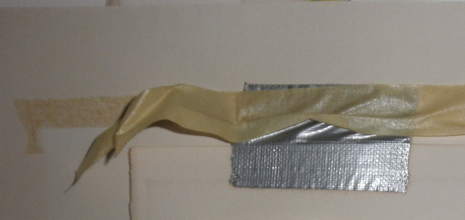 |
| This silver Duct tape was applied to the reverse side of a silk rug. Luckily the Duct tape was only on the rug for a relatively short time. The removal could have been much worse. |
We actually have a file of photographs labeled "good intentions". Here we keep a visual record of the repairs done with the best intentions, that sadly had negative repercussions as the artifact (along with the glue or tape) aged. Of course the applier of the adhesive had good intentions, and at the time, the fix must have seemed like the perfect thing. If only they knew that in the future, the "fix" would need its own fix.
We also have a file of articles and resources that discuss at length the removal of tape and glue. Immersion, poultice, rolling, scraping, scoring, suction table, they all have merits and drawbacks and that actually is not what we will cover here. Instead the focus is on storage and what to do with an artifact that has been taped or glued but cannot be treated for whatever reason.
Let's face it, not every artifact can go to the conservator's studio for treatment, yet it may not be best suited to go into indefinite storage because it contains dangerous or unwanted materials.
Q: So what is the best method to store an item that has conservation needs?
A: The quick answer is store it in a cold, dark environment, with low humidity.
And remember that prevention is better than a cure. Check on the piece often (like every 6 months).
Adhesives are complex things. For instance, unless you have tested a particular tape, you probably cannot easily identify the plastic used to make the carrier, or the chemical composition of the adhesive applied to it.
 |
| Here an aged piece of duct tape has separated into several pieces, the silver back of the carrier, the "fabric" of the carrier, and the sticky adhesive. |
In Franca Manganelli's 1982 article, Careless Use of Adhesive Tape she speaks frankly, "The damage caused is particularly serious as it cannot be undone. The yellowish brown stains left by adhesive tape can never be removed, and if they penetrate from the back of the paper (where the adhesive is generally applied) to the front side, they permanently spoil…in addition the paper becomes fragile and consequently more likely to tear." She goes on to state, "The obvious conclusion is that appropriate information campaigns need to be organized so that these regrettable accidents will no longer occur in the future."
 |
| Here is a compound tape repair. The masking tape has clearly dried and left behind a stain, the duct tape in this treatment was still strongly adhered to the paper and was quite sticky. |
So, if you must store an artifact with tape still applied to it, keep in mind the guidelines above and be sure that it is boxed properly with non-acidic materials. These items need to be conserved, but until that time, do your best to minimize any further damage and remember that the items cannot remain in storage indefinitely.
_____________________________
Gwen Spicer is a textile conservator in private practice. Spicer Art Conservation specializes in textile conservation, object conservation, and the conservation of works on paper. Gwen's innovative treatment and mounting of flags and textiles is unrivaled. To contact her, please visit her website.

No comments:
Post a Comment